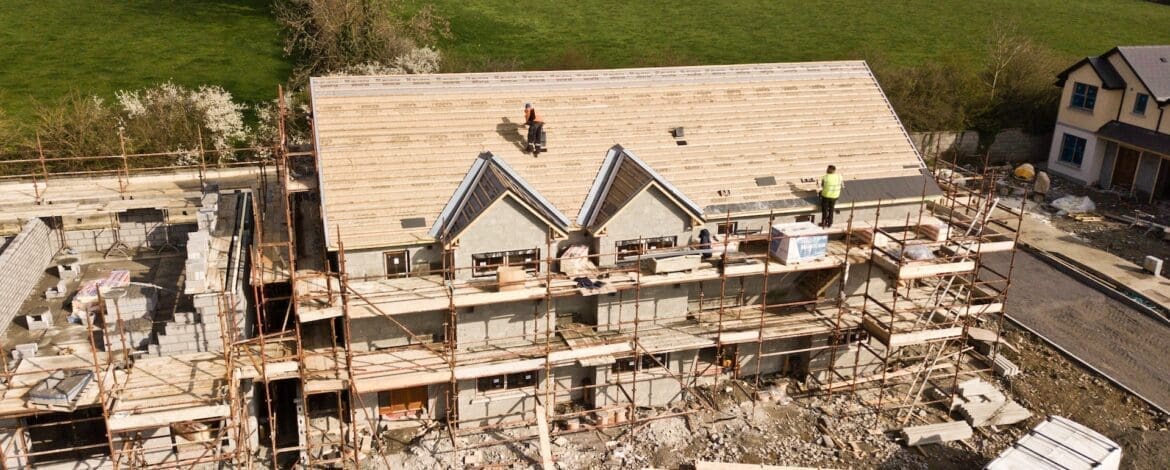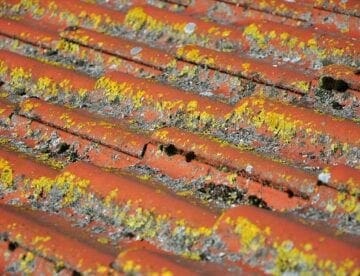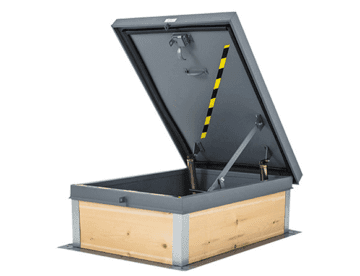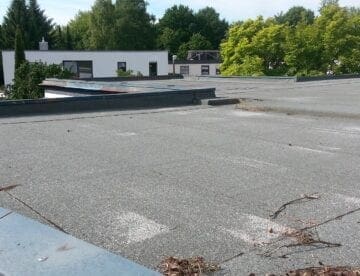Choosing the right type of roof decking materials is critical because it affects the entire roofing system. For example, the base on which shingles, asphalt tiles, or other roof coverings sit must provide a stable foundation. Therefore, not having the right materials for roof decking can result in financial loss, water leaks, and structural damage.
When it comes to choosing what type of material to use for your roof deck, there are several factors you must consider. Typically, roof decking materials are made from plywood, OSB, tongue and groove, or metal. Each of these has pros and cons, as well as purchase and installation costs.
Are you installing a new roof or repairing an existing one? In that case, you must choose the correct type of roofing materials to use.
This article explores the pros and cons of popular options for decking materials to help you make an informed decision.
Types of Roof Decking Materials
Roof decking can use several materials to create a secure support system between the roof structure and the roof covering. Decking systems can be made from wood sheathing, metal, steel, and poured gypsum in building construction. However, the most common roof decking material for residential homes is wood —either OSB, plywood, or tongue and groove.
Plywood
Plywood is the most popular and commonly used roof decking material due to its durability, light weight, and tolerance to moisture. Plywood roof decking is a type of sheathing using layers of wood glued together. This forms a stronger, more rigid material than a sheet of regular timber.
Pros
- Sturdy and strong roof sheathing
- Does not expand due to excessive moisture
- Provides excellent insulation
- It does not contain formaldehyde
Cons
- Costs more than OSB
- Requires a measure of skill to install
- Plywood is the standard choice for most roof installations due to its superior strength and performance.
OSB (Oriented Strand Board)
Oriented Strand Board (OSB) is a great option for roof decking material if you want a strong yet affordable solution. OSB roof deck sheathing consist of wood flakes and strands compressed with glue to create a solid sheet. OSB is popular because of its low cost and excellent strength.
Pros
- Less expensive than plywood
- Easy to install on a roof structure
- Available in large sizes
- Good strength, comparable to plywood
Cons
- Prone to retaining moisture and swelling at the edges
- Heavier to transport and install than plywood
- It appears to be a cheaper material
Overall, OSB is a great choice if you need an affordable and durable material for your roof decking.
Tongue-and-Groove
Tongue-and-groove roof decking boards are a great option for those looking for a durable and attractive roof decking material. This type of decking material consists of interlocking solid wood two-by-six boards with a groove on one edge and a “tongue” on the other.
The main benefit of tongue-and-groove roof decking is in residential properties that don’t have a ceiling. The wood creates a natural ceiling in the house, porch, outdoor pavilion, pool room, or patio.
Pros
- Creates an aesthetically pleasing, natural wood ceiling
- Good insulation
- Strong and stylish
Cons
- Expensive
- It requires skill to install and takes more time
- Difficult to install on roofs with multiple pitches
Metal
Metal is a great choice for roof decking materials, as it offers a variety of benefits. Metal roof decking sheets can be made from zinc, galvanized steel, copper, aluminum, and tin. And there are several types of metal roofing systems available. The style can look like slate, tile, shingles, or standard vertical panels. This makes metal roofing solutions incredibly versatile.
Pros
- It can be made from recycled materials
- Low maintenance costs
- Excellent heat resistance as they reflect the sun’s rays
- Energy efficient
- Long-lasting and durable during storms and hurricanes
Cons
- Expensive compared to wood decking and asphalt roofs
- Requires expert installation
- It can be slippery when wet depending on the finish
- Noisy during rain and hailstorms
- Prone to rusting
If you can afford it, installing a metal roof has long-term benefits. Although upfront costs are higher, you will have less maintenance and repairs than a standard roof.
Factors to Consider When Choosing a Roof Decking Material
Installing a new roof or replacing an existing one is a costly but necessary task. Therefore, ensuring you get a roof that suits your needs, budget, climate, and neighborhood is vital. Here are some things to consider when choosing material for roof decking.
Cost
Determine your budget. The price of roof decking material depends on the type of material, roof style, and project complexity. For example, the difference in cost for an asphalt shingle roof and a metal roof system can be as much as $10,000 for a standard home.
Climate and weather conditions
Climate and weather conditions can seriously impact the longevity of your roof decking material. For example, metal roof decking may suit Florida’s hot and humid climate more than OSB. Additionally, asphalt shingles can deteriorate quickly in constant sunshine and humidity.
Durability and lifespan
Consider how long you need your roof to last. Metal roofs can last for up to 50 years. However, plywood sheathing can last 15 to 40 years, but asphalt shingles only 20 years.
Aesthetics and style
Before choosing the type of roof decking material, think about the roof’s slope and pitch. For example, plywood and OSB decking are recommended for roofs with a steep slope or high pitch. However, metal roofs are recommended for a low slope.
Additionally, what type of look do you hope to achieve? The roof’s appearance should match the home’s style and the neighborhood.
Building codes and regulations
Before hiring a local expert roofing contractor, check that the decking materials comply with local safety and building codes. For example, Florida’s building codes specify decking material thickness, gauge, and weight.
Why Choose One Material Over Another
Each type of roof decking material has advantages and disadvantages. For example, different materials will perform better in different climates. And it is necessary to consider your budget, roof lifespan, and maintenance requirements.
Here are a few advantages of common decking materials for roofs in the Tampa Bay area.
Advantages of Plywood Over OSB
Plywood is lighter, stronger, more durable, and has better resistance to moisture than OSB roof decking. However, plywood costs more to install on a roof.
Advantages of Tongue-and-Groove Over Plywood
Tongue-and-groove roof decking is better than plywood because of its aesthetics. This makes tongue-and-grove decking the choice material if the roof will be visible from the inside.
Advantages of Metal Over Wood Decking
The key advantage of metal roof decking over using plywood or OSB is its resistance to storms, high winds, and hurricanes. Also, Florida’s hot, humid climate can shorten the life span of wood roof decking and asphalt shingles.
Comparing Costs of Different Materials
Choices when installing or replacing a roof in Florida typically come down to cost. Therefore, weighing the pros and cons of using different materials is crucial. For example, if your area experiences severe storms, wooden OSB decking may be prone to swelling, mold, and leaks. On the other hand, metal decking is pricier upfront but offers better protection from the elements than wood.
Related: Four benefits of metal roofing systems.
Takeaway
It’s vital to consider several factors when choosing the right roof decking material. These factors include the project size, budget, climate, and your property’s aesthetics.
Remember that wood decking materials are budget friendly and can offer good value for money. However, metal roofs are more robust and withstand the elements better.




